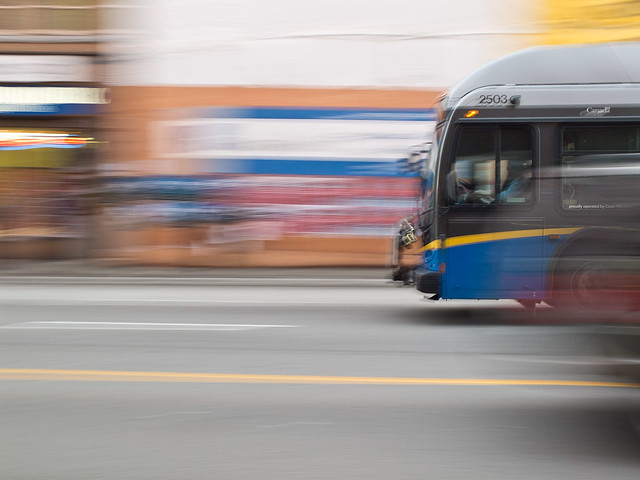I Love Transit 2012: looking back on a life of transit travel with Frances Bula
I Love Transit 2012: looking back on a life of transit travel with Frances Bula


For I Love Transit Week 2012, we’re proud to present a special essay from Vancouver journalist and blogger Frances Bula!
As many of you know, Frances is a long-time Vancouver journalist, specializing in urban issues and city politics. She writes regularly for Vancouver magazine and contributes to the Globe & Mail—and she also maintains a vibrant blog on all things Vancouver over at francesbula.com. Get there now to find out what’s going on behind the scenes at city hall and beyond, and for smart, well-informed commentary on the politics and policies of the Lower Mainland!
Anyway, as you can tell, it’s a huge honour for us to have Frances write an essay on her transit riding experience for our humble Buzzer — and here it is below. Enjoy!
An essay for I Love Transit Week, by Frances Bula
When I was 12, I started to travel to foreign lands. Well, to lands that were foreign for a kid living in North Vancouver, where everything on the other side of the bridges was exotic. That was all thanks to the Sunday transit pass sold back in 1966, which allowed anyone to travel all day long for what seemed to us a phenomenally low sum for a ticket around the world.
For my friends and me, it was our first opportunity to see the city from another vantage point than the back seat of a car. Other kids dreamed of owning cars. But we were ahead of them with our bus passes.
We’d head out Sunday morning and go to big, scary downtown, or all the way down Victoria to the river (the river!) and back, out to the isolated city beyond the forest of the University of B.C., even to Burnaby. We’d ride until dark and come back to our white-bread suburban homes feeling that we had accomplished great things.
Thanks to those travels — mostly on the rounded-corner yellow trolley buses of the era — I discovered that Chinese people lived and ran businesses in the city, that there were other malls besides the one at Park Royal in West Vancouver, and that the world was filled with a weird and wonderful mix of people.
Of course, I’d taken the bus for years before that. My mother first started putting me on it by myself when I was six, in Regina, so I could get to swim lessons at the Y. (Ah, 1960, we’ll never get you back.) But it wasn’t until six years later that I developed my sense of bus travel as a potential adventure, not just a way to get from A to B.
That’s never really gone away. When I lived in Paris for a year in the late 1970s, one of the highlights was my Carte Orange, the pass to the Parisian transit system. For a ridiculous 20 francs a month, I could take any subway, bus or train in the system. My international pals and I roamed the city with our Carte: movies on the Champs Elysees, visits to Oscar Wilde’s tomb at Pere Lachaise, theatre in north Paris, the Mouffetard market near the Sorbonne.
When I went to Hong Kong 20 years later, I got the same wild thrill when I spent a whole day of my two-week trip just travelling on every form of public transit I could find: ferries, double-decker buses, trains.
That allowed me to discover a Hong Kong very different from the post cards of Kowloon streets and the boats in the harbour. I ended up in rural parts of colony where the chickens still roamed, in hidden streets where the refugees trying to cross into Hong Kong were held in detention camps, in shiny suburban new towns that had been built, apparently, the week before.
But my feelings about public transit have changed in the past decade. It is still occasionally an adventure, mostly when I travel to particular cities where attempting to navigate and park a car qualifies as an act of lunacy. Rome, check.
But mostly now I have come to view transit longingly as a place for mental decompression and a little peace. Which sounds strange coming from someone whose most common route is the B-line or the #9 along Broadway — both of them theatrical displays of the complete range of human behaviour, as well demonstrations of the law of physics about two objects not being able to occupy the same space, no matter what the last person trying to squeeze onto the jammed bus thinks.
Yes, it’s often crowded as crazy. But the bus, SkyTrain and Canada Line have one huge advantage: I don’t have to be behind the wheel. After my car-free 20s, I spent two decades driving, driving, driving, the all-purpose chauffeur, hauling service, and personal shopper for a big extended family. I still do a lot of that. Driving, which had seemed exhilarating when I got my first car and started doing road trips, became a grinding chore. It took full-on mental alertness to watch for the Type As rushing through the almost-red lights, the lane-changers with no apparent signalling mechanisms on their vehicles, the meandering pedestrians, the about-to-be-vacated parking spots, the zigzagging bike couriers, the turning trucks that managed to block upwards of four lanes.
So transit became the restful place, where more often than not, I get a seat to myself that lets me experience the full, rich life that’s available when you’re not behind the wheel of a car. I can look out the window and study everything along the route, read my book or Blackberry screen, knit, think about the day ahead, talk (yes! quietly!) with friends I’ve been trying to catch up with for weeks, and more.
My fantasy trip these days consists of combining those two parts of transit – adventure and relaxation – into one. A nice long train trip to the furthest part of North America. I dream of it. The landscape unfurling past my window. Me watching from my quiet haven inside, where I can look and dream.






I love this blog post. Thank you, Frances.
It inspires me to create a web site, that show cases the bus routes that can be used as a joy ride. I’d also like to list all of the bus routes that can form a circle route.